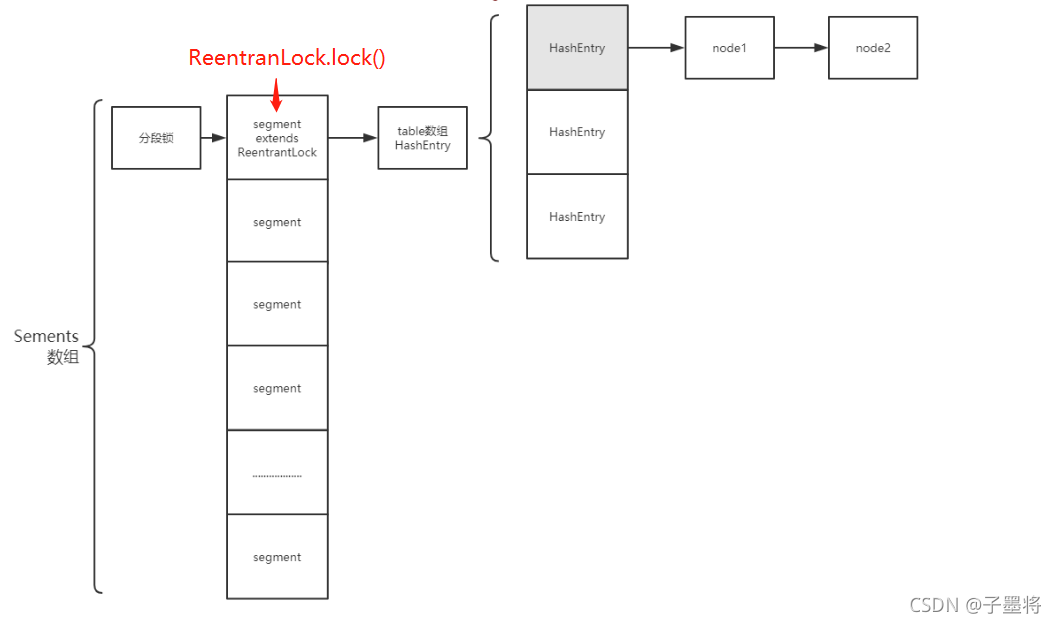HashMap
1. 数据结构
数组 + 链表 + 红黑树(jdk>=1.8)
2. 重要的变量
1.8版本
/**
* 默认初始容量,2的4次方 = 16
*/
static final int DEFAULT_INITIAL_CAPACITY = 1 << 4;
/**
* 最大容量2的30次方, 并且容量必须是2的幂
*/
static final int MAXIMUM_CAPACITY = 1 << 30;
/**
* 默认加载因子
*/
static final float DEFAULT_LOAD_FACTOR = 0.75f;
/**
* 链表转红黑树的阈值
*/
static final int TREEIFY_THRESHOLD = 8;
/**
* 红黑树变回链表的阈值
*/
static final int UNTREEIFY_THRESHOLD = 6;
/**
*链表转红黑树时hash表最小容量阈值,达不到优先扩容。
*/
static final int MIN_TREEIFY_CAPACITY = 64;
4. HashMap PUT
4.1 步骤
- 判断当前table也就是数组是否为空,为空则进行初始化,扩容也就是调用resize方法
- 根据计算出来的hash值 i = ((n - 1) & hash索引,判断当前table[ i ] 是不是为空,为空直接插入
- 接下来就是桶内操作了(一条列表、一颗红黑树或称为桶),定义一个节点e 作为工具人,暂存找到相同hash的节点。
- 获取当前数组table[i] 的节点 p,首先判断是否等于putKey的hash,相等将p节点赋予e节点
- 首节点hash 与 key 的hash 不相等,然后判断其是不是红黑树节点,是就进去遍历树节点,有就返回给e节点,没就先创建新节点返回传给 e 节点。
- 不是树节点,那就只能是链表结构了,遍历链表,寻找节点,也是有就返回给e节点,没就先创建新节点返回传给 e 节点,这里有一个判断,其链表长度是否到了可以转为树的判断,够长了就转红黑树。
- 随后,判断e节点工具人是否为空,不为空赋值操作,覆盖掉记录。
- 判断容量是否需要扩容。
4.2 hash值的计算
//计算hash值
static final int hash(Object key) {
int h;
return (key == null) ? 0 : (h = key.hashCode()) ^ (h >>> 16);
//不是空值,用它的hasecode ^(异或运算符) 它的高16位
//两个二进制数值如果在同一位上相同,则结果中该位为0,否则为1, 这里不是很理解,只知道是减少hash碰撞
}
4.2 (n - 1) & hash
对于(n - 1) & hash 的简单理解
&运算符 两个二进制数值如果在同一位上都是1,则结果中该位为1,否则为0
(n - 1) & hash 通过hash获取索引位置 这个与%(求余)的计算是一样的,只不过这个位运算符效率更高,
为什么不用 n & hash 呢
假如 n = 16,那么此时 n 的二进制为
0000 0000 0000 0000 0000 0000 0000 1000
hash的二进制值为 随便写一个
0000 0000 0000 0000 1000 1000 0110 1010
那么&的结果,就只有两种结果,不是0,就是16,key值就只能放到0或者16的位置上了,很快满出。
而,15的话,就提供了多种可能0-15,也防止了数组越界,妙呀。
0000 0000 0000 0000 0000 0000 0000 0111 15的二进制
0000 0000 0000 0000 1000 1000 0110 1010 hash的二进制
hash是不确定的,那么就有多种组合方式了。
4.2 看看put的代码
//put代码
final V putVal(int hash, K key, V value, boolean onlyIfAbsent,boolean evict) {
Node<K,V>[] tab;
Node<K,V> p;
int n, i;
//如果table 为空 ,或者table的长度是 0 的话,对他进行扩容
if ((tab = table) == null || (n = tab.length) == 0)
n = (tab = resize()).length;
/** 对于(n - 1) & hash 的简单理解
* & 两个二进制数值如果在同一位上都是1,则结果中该位为1,否则为0,
* (n - 1) & hash 通过hash获取索引位置 这个与%(求余)的计算是一样的
* 只不过这个位运算符效率更高,
* 为什么不用 n & hash 呢
* 假如 n = 16,那么此时 n 的二进制为
* 0000 0000 0000 0000 0000 0000 0000 1000
* hash的二进制值为 随便写一个
* 0000 0000 0000 0000 1000 1000 0110 1010
* 那么&的结果,不是0,就是16,key值就只能放到0或者16的位置上了,很快满出。
* 而,15的话,就提供了多种可能0-15,也防止了数组越界,妙呀。
* 0000 0000 0000 0000 0000 0000 0000 0111 15的二进制
*/
if ((p = tab[i = (n - 1) & hash]) == null) //当前位置为空的话,就直接赋值了。
tab[i] = newNode(hash, key, value, null);
else { //此时 p 为数组中已存在的Node node
Node<K,V> e; K k; //这个node e节点只是充当一个工具人,暂存找到的节点,后面赋值更改value值
// 这里判断node的值是否与put进来的key相等了?
if (p.hash == hash &&
((k = p.key) == key || (key != null && key.equals(k))))
e = p; //相等就先将这个p节点 赋值给 e 节点咯。
else if (p instanceof TreeNode) //这里判断该p节点是不是树节点。
e = ((TreeNode<K,V>)p).putTreeVal(this, tab, hash, key, value);
else { //上面都不是,就只能往链表里面遍历一次,看看存不存在该key
for (int binCount = 0; ; ++binCount) {
if ((e = p.next) == null) { //没找到
p.next = newNode(hash, key, value, null); //直接新节点,put进去,尾插法
if (binCount >= TREEIFY_THRESHOLD - 1) // -1 for 1st
treeifyBin(tab, hash); //这里考虑链表需不需要变为红黑树
break;
}
if (e.hash == hash && // 这里表示找到了,终止循环,走下面换value
((k = e.key) == key || (key != null && key.equals(k))))
break;
p = e; // 下一个
}
}
if (e != null) { // existing mapping for key ,已经存在过的key,将他value从新替换
V oldValue = e.value;
if (!onlyIfAbsent || oldValue == null)
e.value = value;
afterNodeAccess(e);
return oldValue;
}
}
++modCount; //记录修改次数
if (++size > threshold)
resize();//长度不够了,扩容
afterNodeInsertion(evict);
return null;
}
5. HashMap 扩容
5.1 Jdk7-扩容死锁
jdk7链表采用头插法
而扩容的方式都是大同小异,都是通过新建一个大一点的数组(通常是2的指数幂,也必须是这样),随后将节点按照位置再安放好。
JDK7 HashMap 扩容在多线程场景下,会形成一个链表环的情况,也就意味着这是一个死循环,况且本来HashMap也不支持多线程的场景
JDK7 扩容代码
void transfer(Entry[] newTable, boolean rehash) {
int newCapacity = newTable.length;
for (Entry<K,V> e : table) {
while(null != e) {
Entry<K,V> next = e.next;//第一行
if (rehash) {
e.hash = null == e.key ? 0 : hash(e.key);
}
int i = indexFor(e.hash, newCapacity);//第二行
e.next = newTable[i];//第三行
newTable[i] = e;//第四行
e = next;//第五行
}
}
}
- 第一行:记录oldhash表中e.next
- 第二行:rehash计算出数组的位置(hash表中桶的位置)
- 第三行:e要插入链表的头部,所以要先将e.next指向new hash表中的第一个元素
- 第四行:将e放入到new hash表的头部
- 第五行:转移e节点,继续循环下去
5.2 JDK8 扩容
Java8 HashMap扩容跳过了Jdk7扩容的坑,对源码进行了优化, 采用高低位拆分转移方式,避免了链表环的产生
JDK8 扩容代码
//扩容的代码
final Node<K,V>[] resize() {
Node<K,V>[] oldTab = table; // oldTab 就是旧的数组table
int oldCap = (oldTab == null) ? 0 : oldTab.length; //旧数组长度
int oldThr = threshold; //旧的扩容阈值=长度*扩容因子(0.75)
int newCap, newThr = 0; //新的长度,新的阈值
if (oldCap > 0) {
if (oldCap >= MAXIMUM_CAPACITY) { //MAXIMUM_CAPACITY = 1 << 30; 2的30次方
threshold = Integer.MAX_VALUE;
return oldTab;
}
else if ((newCap = oldCap << 1) < MAXIMUM_CAPACITY && //oldCap << 1 旧长度的2倍。
oldCap >= DEFAULT_INITIAL_CAPACITY)
newThr = oldThr << 1; // double threshold 阈值扩大两倍,他也只能是2的倍数了。
}
else if (oldThr > 0) // initial capacity was placed in threshold
newCap = oldThr; //oldCap = 0,oldThr > 0 时,将阈值设置为table长度。
else { //oldCap = 0,oldThr = 0 一开始,初始化
// zero initial threshold signifies using defaults
newCap = DEFAULT_INITIAL_CAPACITY;
newThr = (int)(DEFAULT_LOAD_FACTOR * DEFAULT_INITIAL_CAPACITY);
}
if (newThr == 0) {
float ft = (float)newCap * loadFactor;
newThr = (newCap < MAXIMUM_CAPACITY && ft < (float)MAXIMUM_CAPACITY ?
(int)ft : Integer.MAX_VALUE);
}
threshold = newThr;
@SuppressWarnings({"rawtypes","unchecked"})
Node<K,V>[] newTab = (Node<K,V>[])new Node[newCap]; //新长度的一个空数组
table = newTab;
if (oldTab != null) { // 下面就是搬节点的过程了
for (int j = 0; j < oldCap; ++j) {
Node<K,V> e;
if ((e = oldTab[j]) != null) {
oldTab[j] = null;
if (e.next == null) // 只有一个节点,直接拿过去,不用考虑会形成链表环
newTab[e.hash & (newCap - 1)] = e;
else if (e instanceof TreeNode) // 树节点有自己的处理方式。了解红黑树再说
((TreeNode<K,V>)e).split(this, newTab, j, oldCap);
else { // preserve order
Node<K,V> loHead = null, loTail = null; // 低位头节点,尾节点
Node<K,V> hiHead = null, hiTail = null; // 高位位头节点,尾节点
Node<K,V> next;
do {
next = e.next;
if ((e.hash & oldCap) == 0) { //old 旧数组长度
if (loTail == null)
loHead = e;
else
loTail.next = e;
loTail = e;
}
else {
if (hiTail == null)
hiHead = e;
else
hiTail.next = e;
hiTail = e;
}
} while ((e = next) != null);
if (loTail != null) { // 区分好高低位 的节点,直接转移到新数组上面
loTail.next = null;
newTab[j] = loHead;
}
if (hiTail != null) {
hiTail.next = null;
newTab[j + oldCap] = hiHead;
}
}
}
}
}
return newTab;
}
---------------------------------------------------分界线-----------------------------下面吃完饭再回来写------------------------------------
后面再谈谈红黑树
以及用于并发的ConcurrentHashMap
jdk7 用大hash表 套小hash 表 ,基于ReentranLock实现分段锁

jdk8 采用 synchronized + cas 保证线程安全
